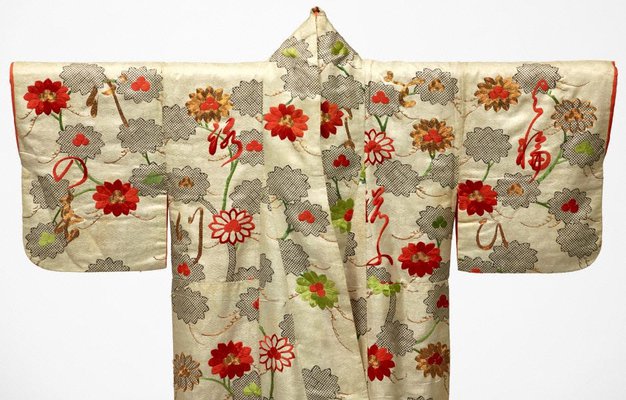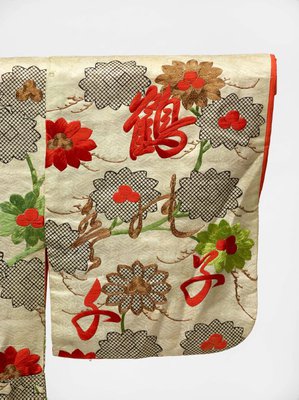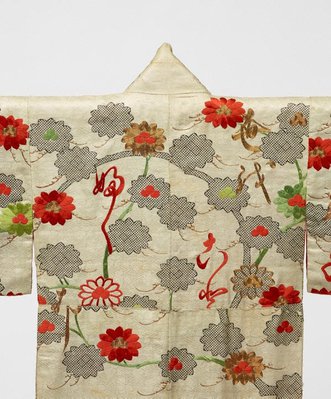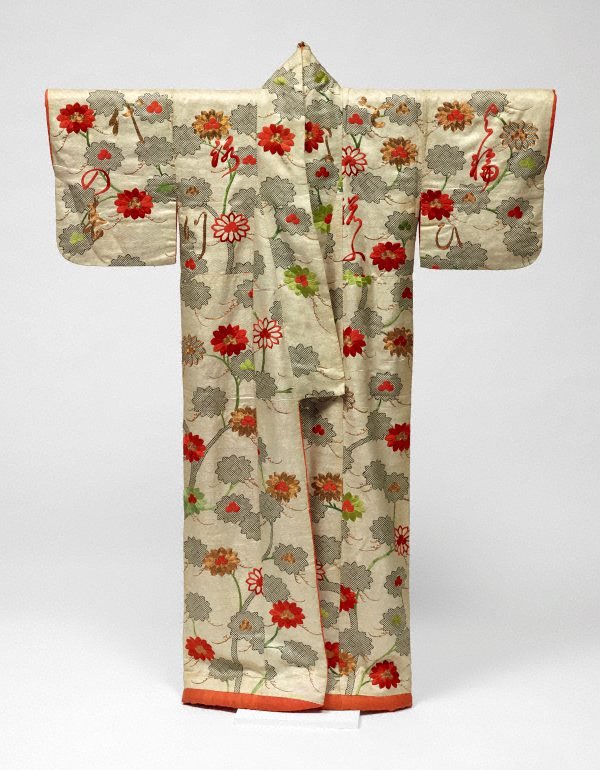




-
Details
- Place where the work was made
-
Japan
- Period
- Edo (Tokugawa) period 1615 - 1868 → Japan
- Date
- 1750-1850
- Media category
- Textile
- Materials used
- silk, stencilled imitation tie-dyeing ('kata kanoko') and silk and metallic thread embroidery
- Dimensions
- 155.0 x 122.0 cm; sleeve: 44.0 x 31.0 cm
- Credit
- Purchased with funds provided by the Asian Art Collection Benefactors 2014
- Location
- Not on display
- Accession number
- 242.2014
- Copyright
- Share
-
-
About
Vertical branches of Chinese pine ('karamatsu') depicted in red, light green and gold embroidery, and 'kanoko' stencilled with black ink cover the front and back of this elegant 'uchikake' (lined kosode worn as overcoat) made of white figured silk satin ('rinzu'). A 31-syllable poem written with red and gold embroidered kanji and kana is scattered across the upper part of the front and back panels as well as both sleeves. It likens the longevity of cranes, which are said to leave for one thousand years, to the eternal beauty of spring. The image of the cranes, evoked here through poetry, complements the pictorialised pine enhancing the auspicious message of a long, fulfilled life conveyed in this garment. Such felicitous robes were most likely produced as a gift for a female member of the military aristocracy on a special occasion such as a wedding.
The arrangement of the pines is typical for a design type known as 'tachiki' (‘standing tree’) which became popular from the 18th century onwards. 'Tachiki' in combination with scattered characters is a classical design reserved exclusively for women of the elite samurai class. Only very few examples of this type of garment remain today, which underlines the rarity and high value of this 'uchikake'.
REFERENCES:
Gluckman, Dale Carolyn & Takeda, Sharon Sadako. 'When art became fashion : kosode in Edo-period Japan'. With contributions by Monica Bethe, Hollis Goodall-Cristante, William B. Hauser, Kirihata Ken, Maruyama Nobuhiko, Nagasaki Iwao, Robert T. Singer. New York/Tokyo: Weatherhill and Los Angeles County Museum of Art, 1992Stinchecum, Amanda Myer. 'Kosode, 16th-19th century textiles from the Nomura Collection'. With essays by Monica Bethe and Margot Paul ; edited by Naomi Noble Richard and Margot Paul, New York: Japan Society and Kodansha International, 1984.
Asian Art Department, AGNSW, 2014.
-
Places
Where the work was made
Japan
-
Exhibition history
Shown in 2 exhibitions
Conversations through the Asian collections, Art Gallery of New South Wales, Sydney, 25 Oct 2014–13 Mar 2016
Beyond Words: Calligraphic Traditions of Asia, Art Gallery of New South Wales, Sydney, 27 Aug 2016–30 Apr 2017
